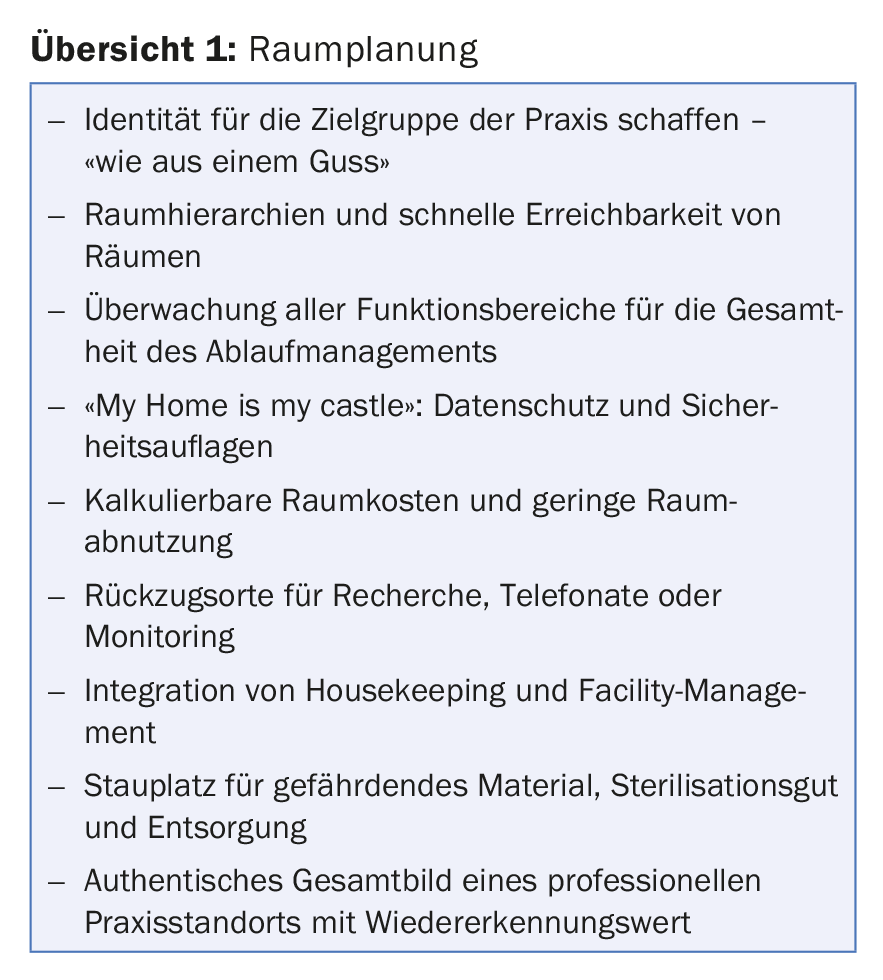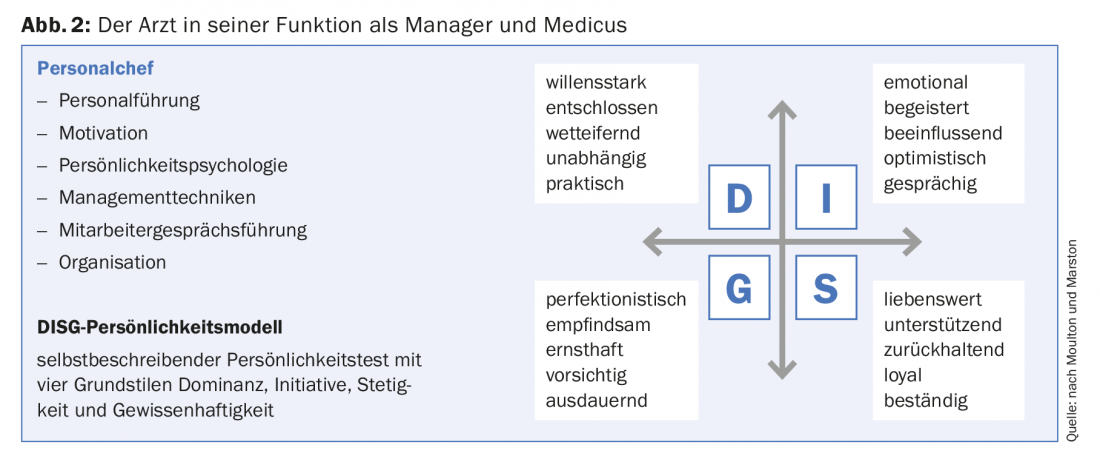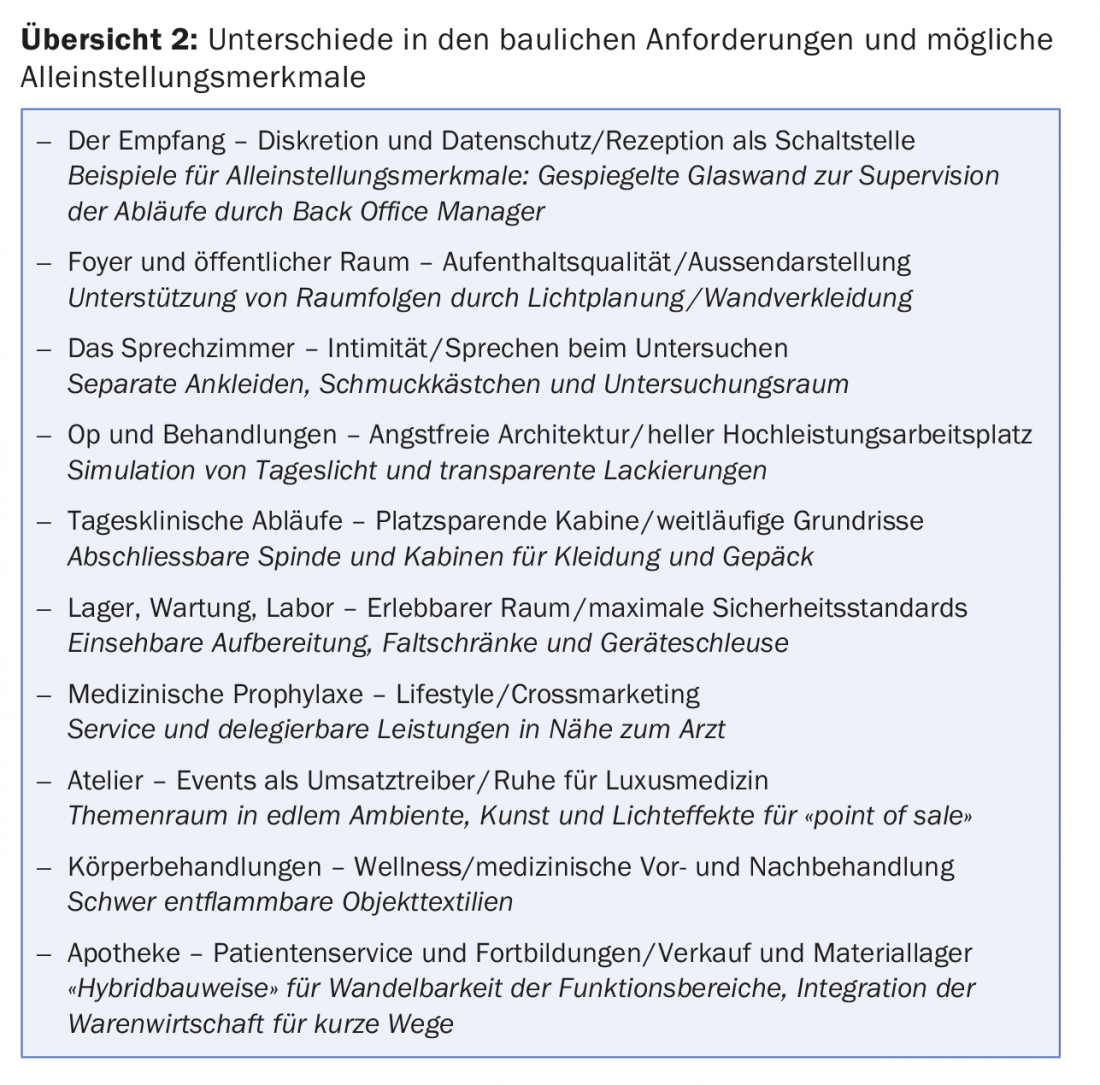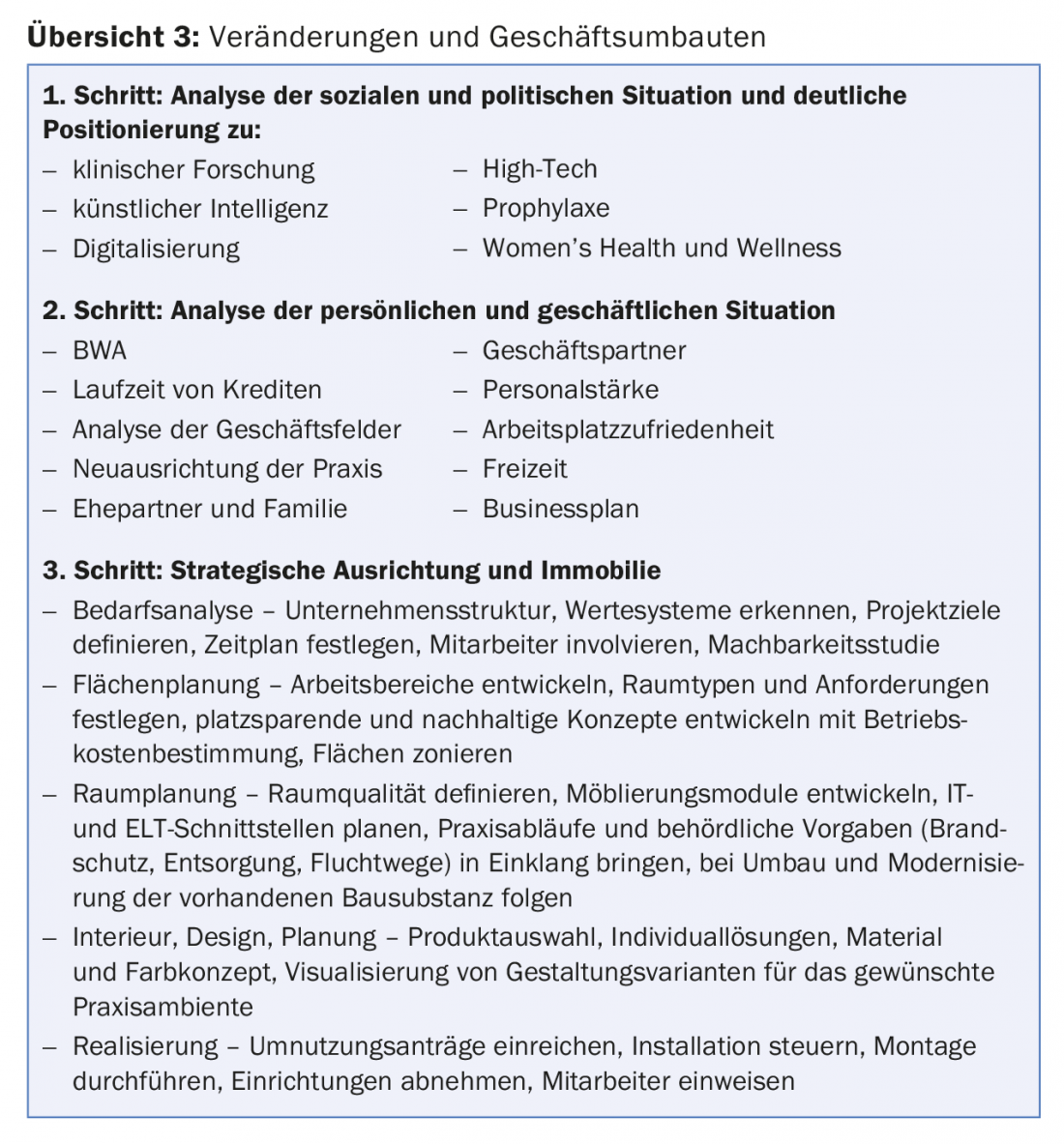Establishing and maintaining an aesthetic dermatology practice – a challenge in communication, personnel management, room design, financial planning and change management. Where are the stumbling blocks? What is the secret to a successful practice?
The dermatologist is the main contact for aesthetically motivated questions and treatment requests. In aesthetic dermatology, surgery, medicine and cosmetics flow together. I myself work as a dermatologist in a solo practice – a form of organization that is considered a discontinued model, but is still widely used in dermatology. The practice has now been in existence for ten years and there are still many construction sites. Money was also misinvested. A few general principles for aesthetic dermatology practice that I believe will keep you on track for success are presented in ten short chapters.
Social competence – recognizing needs, ordering symptoms
Managing staff, communicating with public decision makers, and interacting with diverse characters require a high level of interpersonal skills in addition to diagnostic skills. With the patient, on the one hand, it is a matter of identifying needs, sorting out symptoms, establishing working hypotheses and drawing up therapy plans in a matter of minutes. On the other hand, communication often deals with findings that are unpleasant for the patient (discharge, incontinence, hemorrhoids); several concerns, which not infrequently extend from head to toe and are of equal importance in the patient’s perception, must be ordered. For you, the highest attention is required, because the trifle could be relevant: a pimple on the lip that turns out to be a squamous cell carcinoma, the spot under the nail as an acral melanoma, the skin appendage as a condyloma. Regardless of whether you are an aesthetic dermatologist or a conservative and aesthetic practitioner, you should take this first step of the diagnostic process especially seriously. Social skills help you identify patterns of behavior, anticipate things, and implement systematic procedures that I like to call “navigational medicine” (since, like a captain on the high seas, you need to keep a clear course without alienating, alienating, or even discouraging necessary treatment). How do I go about it myself? After the introductory conversation, I ask the patient to come into the treatment room. There you will find a wardrobe, disposable shoes and a cloth cape. Rapid tests (e.g. HPV 16), technical applications such as reflected light, fluorescence, OCT and 3D camera systems are used to objectively record findings and improve documentation. For aesthetic findings related to appearance harmony disorders, morphometric methods and software systems for quantification such as Trichoscale (hair density), Primos (skin surface) or Elcat (microcirculation) have proven effective. Back at the desk, I summarize the examination for the patient and, together with him or her, determine the sequence of measures, appointments and the start of treatment. If desired, a written recommendation or an independent beauty consultation (we call it “ichKonzept”) is provided, which serves as an orientation for the next aesthetically motivated therapy steps.
Recommendation: In aesthetic medicine, as in other disciplines, one is confronted with different categories of symptoms and patient requests. Some are not willing to perform elaborate operations, their concerns are more in the area of antiaging/maintenance. This target group in particular promises a high continuity of aesthetic treatments.
Patient in focus
There are days in the daily routine of the practice when everything runs perfectly. The staff is fully present and organized – everything is prepared, the start of the working day is successful. The patient is in a good mood. He appreciates your expertise, pays for all concerns without demand, and benevolently puts himself in your hands so that you can practice your healing art. The procedure is performed smoothly and the patient praises not only the result, but also the feeling of well-being during the treatment, which was structured and without pain. He would recommend you, this practice is something special – they look forward to the next visit.
But everyday life is unfortunately often different. The employee is sick, the patient arrives late but wants to keep subsequent appointments and urges prompt treatment. The laser is on strike, showing an error message that you cannot fix. A replacement device must be brought, which worries the patient. Another patient complains that he was bleeding afterward and that the dressing had slipped. A not so good day. Not every inconvenience is foreseeable or within your area of expertise to remedy. Can you really make sure at all times that the elevator is working or that the builders in the courtyard are not turning up their radio too loudly? Nevertheless, the good reputation also depends on the overall presentation of the practice. Contact with the patient does not begin with the doctor-patient conversation (Fig. 1) . Your reputation, the quality of the staff, the equipment of the practice, your social commitment and standing in the medical environment are often the first indicators and possibly also the motivation for a call. Other important factors are the telephone greeting, courtesy and information at the reception, waiting time and atmosphere in the practice, accessibility, parking spaces and the influence of the target group (does the patient feel well taken care of and in the right place from the start? Do first interesting conversations between patients perhaps result?). The doctor-patient contact is the culmination of the visit, though the best diagnosis and therapy are of little help if there is a lack of interpersonal components, a poor atmosphere at check-out due to incompetence, prescription or appointment errors, or indifference.
Recommendation: The first impression counts – and the last one remains in the memory. Work on service-friendly processes and appointment preparations (“concierge medicine”). Have external impact assessed via neutral observer.

Self presentation and practice management
The keyword is: authenticity. Too great a discrepancy between reality and appearance, e.g. on the homepage, unsettles the patient and discourages a second visit to the practice. Patients have a fascinating sense of the vibe between you and the staff, how closely you communicate, how professionally you coordinate, how tightly you hold the reins. A small practice must first develop into a brand in order to grow dynamically. You should continuously work on this goal. This includes your self-presentation and strategic direction of the practice. It makes things easier if the patient knows what you and your staff stand for, in which area you are particularly competent, even before entering the practice. Describe your practice profile in a few sentences. Could you summarize your range of services off the top of your head and in one sentence? Have you clearly defined all the unique selling points? When presenting yourself, remain authentic. You do not bind a patient by making dubious promises. Less is more. Have your staff, colleagues, or treated patients talk about your awards. Show therapy concepts in publications or textbooks, speak in the subjunctive and, in the case of aesthetic procedures that can be planned, even ask once whether your counterpart is ready for the procedure. A serious “no” will be rewarded in the long run. Especially at the beginning of the job, it seems untrustworthy if you start your practice career as a self-proclaimed “universal genius”. The residency prepares only to a limited extent for the day-to-day practice of an aesthetic dermatology specialist. The integration of new devices is also always subject to a learning curve.
Recommendation: The mixing of offers from statutory and private health insurance, studies and aesthetic services at the same location without clear spatial separation and independent staff leads sooner rather than later to a loss of revenue in one or the other area and to increasing uncertainty for the patient due to competing processes.
Workplace and “feel-good place
Rapid changes in the practice landscape, new healthcare markets, demanding patients and valuable, highly sought-after employees demand attractive spaces for work and healing, despite enormous cost pressures. Rooms are like a “second skin”, affect feelings and thoughts. They have a power on us that we are rarely aware of, and hold great motivational potential. The first time a patient steps into the office, they decide if they “feel at home.” Ideally, the practice should be experienced as a “feel-good” place for patients and staff, and the architecture should convey warmth, safety and security. Good space planning pursues the goal of a consistent style and practice identity. However, perception also depends on the age group, the treatment process and the severity of the procedure. One patient requires an architecture that takes away the fear of the surgical procedure: modern, safe and hygienic. Children want to move and play in the waiting room. Lifestyle and trends play a role in cosmetics. Here the practice follows individual ideas of comfort (ritualization of procedures, harmony of colors, fragrance, heated couches and cozy textiles).
The location and infrastructure of the practice must reflect your practice philosophy. An aesthetic practice is based on the standards of international hotels. The interior design sets the scene for the various processes. Let your interior designer make creative suggestions, meticulously monitor feasibility and compliance with regulatory standards. Draw a clear practice profile and think through processes (“form follows functionality”). Avoid “all-in-one” rooms, even for cosmetic services. The functionality of a room for different processes is kept within narrow limits. Distinguish between “to go” and more time-consuming and personnel-intensive procedures based on the classification of the procedure. Plan functional areas with space for emergency, monitoring, supervision and storage space. Here, in addition to the central storage area, a niche in the treatment area is also recommended for temporary storage of the sterile goods. Overview 1 summarizes important points regarding space planning.
Recommendation: Draft a master plan (even if you are taking over the practice) and have it visualized by an architect before awarding a contract and appointing the construction manager. Anchor your business idea consistently in the room design.

Physician-Patient Communication
How do I communicate with the “difficult patient”? How do you strike the right note with different age and social groups? How much information do I transport? Do you keep certain “wisdom” to yourself? Action or inaction, words or silence – both have the character of communication (“one cannot not communicate”). Show a level of sensitivity, openness, and a basic willingness to engage with your patient. Despite all the administrative or financial burdens, there is usually still potential to optimize processes and create scope for communication through clever organization. And there are strategies for successful communication. Don’t underestimate the impact of open doctor-patient communication on health. Psychosomatic symptoms must be recognized by a trained eye and objective questionnaires.
Recommendation: Even with the best education, there are deviations in the implementation of the therapy recommendation (lack of adherence in up to >50%). Separate yourself from reluctant and unsympathetic patients. They will not find salvation in them. However, it would be better to get to the root cause of the impaired communication. The prerequisites of doctor-patient communication also include structured conversation with eye contact in a professional setting.
Personnel and management style
The labor market situation in Central Europe makes it difficult to obtain and retain qualified personnel for smaller facilities. Lack of attractiveness of work in the medical environment, frequent changes of location and workplace, favored by modern media and head-hunter organizations, play a role along with other factors. But even if all positions in your practice are filled with permanent contracts and permanent staff and you have created a positive environment, you will not be able to prevent losing employees or you will have to part with a “top employee” (e.g. in case of conflict potential). A few aspects of personnel management (Fig. 2) may nevertheless be helpful: Put together a harmonious basic team, in the sense of an “anchor” for the practice. Continuous arguments, know-it-all attitude and false actionism are not desirable in a practice. Define the workspace in simple terms. Determine the right personality types – dominant (D), initiative (I), steady (S), conscientious (G) – for the respective task areas (specifically promote employees’ strengths). Prevent the formation of clumps. See the big goal in front of you and communicate it consistently. Don’t show disappointment too openly, but accentuate the positive. Never speak ill of colleagues or staff in the day-to-day running of the practice, and provide incentives that keep the team together. Try to seal off the practice to the outside world against unnecessary attacks from competitors.
Recommendation: A calm and friendly atmosphere is a sales guarantee and the basis of a successful and prosperous practice. Separate yourself from troublemakers – regardless of reservations or severance payments.

Expert network
As a practice owner, you are a physician and an entrepreneur. Regardless of the size of your practice, you will be confronted with entrepreneurial and organizational – per se non-physician – challenges on a daily basis. Rank these business areas for yourself according to importance and urgency. Then consider what areas you could take on yourself in parallel with running the practice. All areas, from medical law to quality assurance and accounting to bookkeeping and materials purchasing, could theoretically be staffed by experts, which is not financially feasible. On the other hand, you should not leave out any aspect, because omissions put you in an unnecessarily bad position in the event of a claim. Define time, staffing and resources for the non-medical business area and think through worst-case scenarios. Invest in a proactive approach and external industry-experienced consulting to analyze processes and existing company structure (management consulting). Find out in advance about relevant offerings from professional associations, service centers, chairs, service providers, government agencies, and contact professionals in the various fields. Create a “virtual network” of on-demand experts that includes not only lawyers, tax accountants and bankers, but also practice setters, clothing services, programmers, PR, equipment maintenance and – increasingly important – a network operator.
Recommendation: Delegate unimportant activities. Protect sensitive data from being viewed by unauthorized employees and prevent data theft (e.g., through an IT hierarchy).
Financial planning
Financial planning includes fixed costs, variable costs, and capital expenditures. The amount of investment costs in particular is usually underestimated. New construction, remodeling and renovation are significant costs not only at the beginning of a practice startup. How do I act before the start of the construction project? Where do I want to position myself with my practice? And is the desired goal worth the time and financial risks? Are you competitive given the changing practice landscape? Even with professional construction planning and construction projects with planning from a single source, discrepancies between construction management and trades, improper construction or delivery problems are common. This is especially true for custom-made products. Define your start-up project on the basis of a business plan with a list of unique selling points (overview 2), with competitive analysis, strategy (service and price), advertising strategy and recruitment options, risks of practice development and risk minimization, opportunities and analysis, realization roadmap, conversion applications, financing and investments. Draw a grand design, but plan realistic development steps that you will implement in consultation with funders. Save reserves for back payments and set up your practice broadly. Don’t forget to plan for international patients and other revenue streams. Some large companies are going a step further to better plan, build and operate construction projects. Building Information Modeling (BIM) is about the digital bundling of planning data in one system. This makes it possible to first complete the building virtually before it is actually built.
Recommendation: When starting a new practice or taking over an existing one, always recruit management consultants, project managers, architects, construction managers, practice and interior designers, product consultants, fitters and manufacturers in advance and coordinate their activities.

Materials Management
As head of finance and controlling, you need a few tools besides the classic BWA to protect you from the “crash”. From the large range of key figures, the key figures for productivity, profitability and liquidity have proven themselves in my view. How much is my working hour worth? What is the cash flow from my best power? How much money do I lose per day when I am not working in the office? Where does money flow uncontrolled? The larger the practice, the more important the accounting in terms of materials and purchasing. Get a comprehensive market overview on a regular basis and avoid buying cheap in the short term or committing to long-term contracts. Assign a staff member to purchase materials who can conduct the initial negotiations. In the following, negotiate with companies specifically about offers for your practice (special offers are aimed at the general public) – regardless of short-term trends. Build reserves for unforeseen costs such as injunctions. Keep your logistics simple and clear. Avoid expensive inventory management systems for selling a few products. Avoid “overengineering” and expensive software updates. Benefit from the inventions of colleagues that really benefit you, e.g. expiry date control software by the Carpi couple from Munich, which not only prevents you from accidentally giving out expired medicines to patients, but also ensures that you keep track of materials and resources.
Recommendation: Many rules of the free market economy are not transferable to the business fields of the physician. Medical associations are meticulous in making sure that you do not violate the special meaning of the medical profession and the trustworthiness in your person. As a practice owner, refrain from doing dishonest things like advertising unnecessary services or dubious trends. Avoid focusing on complicated pricing of your medical services, as well as discounting or selling out your services and supplies.
Change Management
Everything has a half-life. Life cycles affect society, the economy, drug development, but also your practice. Standstill is regression. Your practice needs ongoing direction and some projects to continue between the start-up phase and the dispensing phase. Fire a “rocket” now and then to stay in the conversation. How about a new website or a new laser? To uncover trends and keep our finger on the pulse, we invest in a market research firm (EBC) and its market research assistants, who collect data from our patients once a month on a number of topics and present trends to the team that can be incorporated into project planning. In addition to smaller projects from the think tank, the continuous alignment of a practice to the market requires ongoing investments in modernization, conversion and new construction. However, you should not “shoot from the hip” when it comes to construction projects, because there is always the risk of unplanned costs. These are particularly common in the case of hasty construction decisions, e.g. conversion measures out of necessity, after the separation of partners, the integration of new business areas or the sale of a property. Three steps have proven to be effective in making trend-setting changes or business conversions within a reasonable time and budget (overview 3).

Recommendation: The ideal practice does not exist. At best, a holistic appearance in the sense of a corporate identity is created. This includes a clear infrastructure and the consistent presentation of services, but also being able to react quickly and cost-effectively to unforeseen events. Revive your business idea not just once, but over and over again in front of employees and outsiders. With every well-organized project, you attract new patients and retain your old ones.
DERMATOLOGIE PRAXIS 2018; 28(4): 20-26











